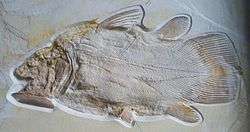Libys
| Libys Temporal range: Jurassic | |
|---|---|
| | |
| Lybis superbus, at the Jura Museum, Eichstaett | |
| Scientific classification | |
| Kingdom: | Animalia |
| Phylum: | Chordata |
| Class: | Sarcopterygii |
| Subclass: | Actinistia |
| Order: | Coelacanthiformes |
| Family: | Latimeridae |
| Genus: | Libys Münster |
Libys is a genus of the prehistoric coelacanth lobe-finned fish, an intermediary form between sea and land animals. It belongs to the family of Latimeridae, which is also the family of the living coelacanth, Latimeria. These fishes lived during the Upper Jurassic period (Kimmeridgian - Tithonian, about 150 to 145 million years ago).
Description
Libys had an exceptionally squat body, especially when compared to other coelacanths of the same period as Undina and Holophagus species. Libys could reach 60 centimeters in length and was therefore a medium-sized coelacanth, with a short and high skull. The pectoral fins were quite long, while the tail was remarkably short and high
Distribution
Fossils of these fishes have been found in Germany, in the famous deposits of Solnhofen.
Species
- Libys superbus Reis, 1888
- Libys polypterus
Genus Libys has been described for the first time in 1842 by Muenster. The species Libys polypterus was then established as the type species, on the basis of fragmentary remains. Later has been described another species (Libys superbus), on the basis of a complete large specimens, but most authors believe that these two forms have in reality to be considered conspecific.
 Libys superbus at the Teylers Museum, Haarlem |
Libys superbus at the Naturhistorisches Museum, Wien |
References
- Biolib
- The Paleobiology Database
- Paul H. LAMBERS A redescription of the coelacanth Macropoma willemoesii VETTER from the lithographic limestone of Solnhofen (Upper Jurassic, Bavaria)
- History of the Coelacanth Fishes by Peter L. Forey, Chapman & Hall, 1998.
- von Dr. Peter Wellnhofer Der Quastenflosser Latimeria - ein "lebendes Fossil"